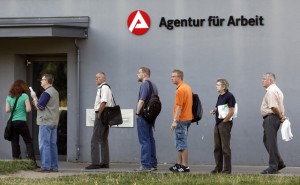 German unemployment dropped during August, while manufacturing increased momentum, signaling that the largest economy in Europe would maintain growth.
German unemployment dropped during August, while manufacturing increased momentum, signaling that the largest economy in Europe would maintain growth.
Joblessness fell by 7,000 on a seasonally adjusted rate to 2.79 million said the Federal Labor Agency located in Nuremberg on Tuesday.
The rate of unemployment stayed at 6.4%, while the manufacturing Purchasing Managers’ Index rose from July’s reading of 51.8 to 53.2, which is far above the level of 50 needed to indicate expansion.
The labor market in quite stable as well as robust, said a leading economist in Frankfurt. Amidst a weakened global economy due to a dynamic China, the domestic consumption in Germany is of more importance than ever before, and that is where the country’s labor market becomes a crutch for the economy.
Economists predicted a drop of 4,000 in unemployment. The amount of people who do not have worked dropped by 3,000 in the western part of Germany, while about the same number of 3,000 were in the eastern part.
The jobless rate for the euro zone consisting of 19 nations slid unexpectedly to 10.9% during July, the lowest amount since February of 2012 showed data from the statistics office of the European Union on Tuesday.
Economists in a survey predicted that the unemployment rate for the eurozone would hold steady at 11.1%.
A gauge for manufacturing in the eurozone eased from 52.4 in July to 52.3 for August. Markit data showed that the input costs at the factories within the region dropped for just the first time in the past six months and sales prices hardly grew.
One positive sign was the new orders gauge rose to its highest mark in over one year, while demand improved as well.
